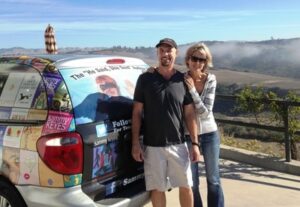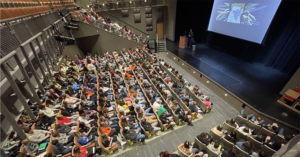 by Mark Parsons
by Mark Parsons
Click here if you missed Part III.
There is the theory of and the planning of, but sooner or later you face the doing of.
A typical day on book tour might start with packing up and checking out of the hotel, then traveling to the next stop where, assuming you’re a PB/MG/YA author, you may have a midday school visit.
We learned early on not to unpack and put clothes in the dressers or closets. Suitcases on suitcase racks are way more efficient, and you won’t leave things behind. We prided ourselves on how quickly we could move in or out and used to hum the Mission Impossible theme when doing it.
Add an extra ten minutes when presenting at a school. You’re almost certainly going to need to visit the admin office first to sign in and receive a visitor’s badge. At many schools there is no other way to physically access the campus. Then the librarian or teacher who coordinated your visit will escort you to the cafeteria/gym/MPR for your presentation. Go to the venue and prioritize getting the tech up and running before doing too much meet-and-greet. Almost all schools have someone to help with this, and they range from total tech wizards to flustered/overworked teachers who aren’t familiar with the equipment.
Pro tip: Put your presentation on a thumb drive and backed up on your computer as well as in one other location. We try to use their equipment and present off our thumb drives when possible, but more than once the day was saved because we brought our computers with us. Multiple cables and adaptors to interface between your computer and their projector/system are worth their weight in gold. I bring a couple of small USB pointer/clickers, because there’s nothing that kills the flow of a presentation more than having to run back to the computer to advance each slide or waving at someone to change slides for you. And finally, be able to give some semblance of your presentation without any technology at all, because sooner or later you’ll have to. Trust me on this.
 You’ll want to have an educational component in your presentation. Teachers, librarians, and principals will appreciate this; you’re at a school, after all. But also something entertaining for the kiddos. While you want to talk about your work at some point, what you don’t want to do is show all your books and give a sales pitch for each. No one will like this approach, adult or student. Don’t forget to give credit to the store that selected the school. My brilliant wife makes a slide for the top of each show that basically says, “Sponsored by XYZ Bookstore” with the store’s logo, and this is on the screen when the students file in. Often the store will have a rep at the school, either to watch or to hold a sale afterward. They always appreciate the shout-out. At the end, also mention you’ll be at the sponsoring store that evening to take questions and sign books.
You’ll want to have an educational component in your presentation. Teachers, librarians, and principals will appreciate this; you’re at a school, after all. But also something entertaining for the kiddos. While you want to talk about your work at some point, what you don’t want to do is show all your books and give a sales pitch for each. No one will like this approach, adult or student. Don’t forget to give credit to the store that selected the school. My brilliant wife makes a slide for the top of each show that basically says, “Sponsored by XYZ Bookstore” with the store’s logo, and this is on the screen when the students file in. Often the store will have a rep at the school, either to watch or to hold a sale afterward. They always appreciate the shout-out. At the end, also mention you’ll be at the sponsoring store that evening to take questions and sign books.
After the school presentation and some version of checking in/unpacking/eating, you get to the bookstore. As with a school, it pays to arrive a little early. Greet the owner/coordinator, get the lay of the land, browse the shelves if there’s time, meet some customers if there’s time, grab a coffee if available, and get ready for your presentation.
As mentioned previously, there are a few different types of signings. Your mileage may vary, of course, but here’s broadly how I categorize them.
Sit & Sign
This is where the store parks you somewhere at a table with a stack of your books, typically near the entrance, or maybe in your genre’s section if it’s a big store. You’re left to try to engage customers as they walk by, hoping it leads to a discussion and maybe even a sale. This is usually not the best experience, and we try to avoid it if there’s another option. You’re engaging with people who aren’t there to see you and likely aren’t even interested in the type of book you’re presenting. There’s no real draw to this sort of signing unless you have fans/friends/readers in the area who will make the trip to see you, other than the fact that it can lead to signing a fair amount of stock. The larger chain stores tend to go for this, so sometimes the stock signing can be significant. When we sign stock we always volunteer to put signed by author stickers on the books, because it increases the likelihood that book will sell down the road. Chain stores will have a big roll of these, or you can bring your own to smaller stores. Also, as there is no actual presentation, it’s harder to give the customers much of value during a sit-and-sign other than occasionally taking questions one-on-one.
Read & Sign
This at least offers customers the “value” of hearing you read from your work. Usually your latest, which they likely haven’t read yet, like a trailer or teaser for your new book. I put value in quotes because you’re giving them something they can get simply by picking up the book and perusing a chapter. I’m not a huge fan of readings, either as attendee or presenter, but if the audience consists primarily of fan-ish readers, which it usually doesn’t (see below), then this might work well for you and your attendees. At least you typically have the trappings of a presentation—chairs for them and a place in front for you—and there is some interaction between reader and author. And of course you can do a Q&A afterward, which is even more interactive.
Presentation w/Q&A
This is our favorite, because it has something for everyone. As mentioned, a high percent of people want to write a book. Of course, some of them are writers, actively writing and/or trying to publish. These people are even more interested in speaking with you. The details regarding deciding on the specifics covered in an author presentation might make a good post unto itself, but a few popular topics include where writers get ideas, the journey to publication, making the creative life work, the writing process, and a peek behind the publishing curtain.
A big key to reaching the audience is knowing whom you’re addressing. We like to do a quick assessment first via a show of hands regarding how many have an interest in writing someday, how many are actively writing, how many have a draft they’re in the process of shopping, how many have no interest in writing but are avid readers, etc. Then we tailor the presentation to them.
Another key factor is not making the presentation about you. Ideally, it should focus on them, and give them something that can help them get where they want to go. There’s nothing more boring than some dude droning on and on about himself and his books, his story, his process, his life, etc.. And of course, the way to make sure you’re giving the attendees what they want is to be as interactive as possible. Sometimes the bulk of the presentation ends up being a lively hour-long Q&A session. A bunch of concise answers will usually be better than a few long dissertations here. Regardless, we always try to do a lightning round near the end
where we answer a bunch of questions quickly, because there’s nothing worse than someone sitting through a presentation and not getting a chance to ask their question.
After you’re done you sign books for the attendees, of course, and always be sure to ask the store if they’d like you to sign stock.
And always thank the staff profusely for hosting your visit. This is a mutual-aid thing. Yes, you’re taking the time to present, hoping to bring people into their store, maybe even new customers. But they’re allowing you to present your work in their establishment, which costs them in terms of time/work/money. You want to leave them feeling good about you and your books, and they want you feeling good about their store. Win-win, right?
I can honestly say that we’ve met booksellers and school librarians who’ve become lifelong friends, which shouldn’t be too surprising. After all, we have a shared love of books.
Happy touring!
Mark Parsons is a frequent presenter at conferences, festivals, and schools, speaking on the craft and business of writing. He is a critically acclaimed YA author—his newest novel is The 9:09 Project, out now from Delacorte/Random House. He has written extensively in the nonfiction arena, authoring over two-hundred articles for national publications as well as a pair of nonfiction books.
